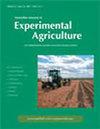Linking rumen function to animal response by application of metagenomics techniques
引用次数: 28
Abstract
Metagenomics techniques applied to the rumen microbiota have demonstrated tremendous diversity originally among populations of bacteria and, more recently, among the methanogenic archaea, including those associated with protozoa. Although with some potential limitations, cluster analyses of sequences recovered from clone libraries have revealed differences in populations among animals fed forage v. grain, including amylolytic ruminococci and novel groups of clostridia adhering to the rumen particulates. Rapid profiling procedures, such as denaturing gradient gel electrophoresis (DGGE), can be used to infer likely differences in community structure of bacteria and archaea among numerous replicates of animals and times after feeding diets that are more representative of intense ruminant animal production. Metagenomics procedures also are being applied to issues related to ruminal output of fatty acid isomers influencing milk fat composition and consumer acceptance, the environmental impact of nitrogen in animal waste and methane emissions, and future potential approaches to improve ruminal fibre digestibility. If varying concentrations of ruminal metabolites and fluxes quantified from microbial processes can be combined with results from metagenomics applied to rumen microbiota, then we should reduce the unexplained variability in models in which the prediction of nutrient supply to the intestine is synchronised with nutritional guidelines for more efficient feed conversion by ruminants.应用宏基因组技术将瘤胃功能与动物反应联系起来
应用于瘤胃微生物群的宏基因组学技术表明,最初在细菌种群中存在巨大的多样性,最近在产甲烷的古菌中,包括与原生动物相关的古菌。尽管存在一些潜在的局限性,但从克隆文库中恢复的序列聚类分析已经揭示了饲料和谷物饲料动物群体的差异,包括解淀粉性瘤胃球菌和粘附在瘤胃颗粒上的新型梭菌群。快速分析程序,如变性梯度凝胶电泳(DGGE),可用于推断细菌和古菌群落结构在多次重复的动物和饲喂更能代表强烈反刍动物生产的饲料后的时间之间的可能差异。元基因组学程序也被应用于与影响乳脂组成和消费者接受度的脂肪酸异构体的瘤胃产量、动物粪便中氮和甲烷排放的环境影响以及未来提高瘤胃纤维消化率的潜在方法有关的问题。如果从微生物过程中量化的不同浓度的瘤胃代谢物和通量可以与应用于瘤胃微生物群的宏基因组学结果相结合,那么我们应该减少模型中无法解释的变异,在这些模型中,对肠道营养供应的预测与反刍动物更有效的饲料转化的营养指南同步。
本文章由计算机程序翻译,如有差异,请以英文原文为准。
求助全文
约1分钟内获得全文
求助全文

 求助内容:
求助内容: 应助结果提醒方式:
应助结果提醒方式:


